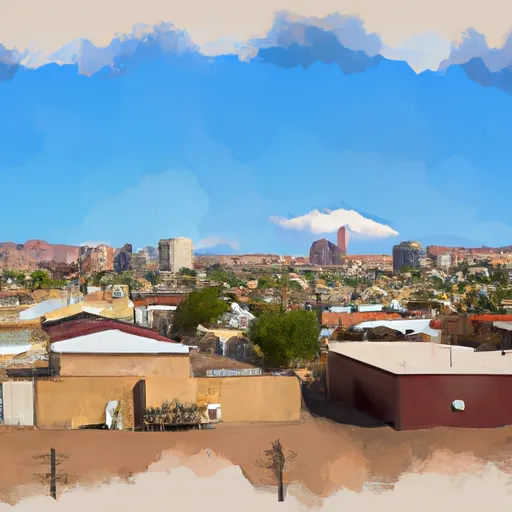-
 Snoflo Premium
Snoflo Premium
Get unlimited access to all our content
With no Ad interruptions! - Start Your Free Trial Login with existing account
Taylor
Eden Index
Climate
8.9
•
Recreation
3.9
•
Community
2.0
•
Safeguard
5.4/10

Taylor, Arizona is a charming town located in Navajo County, in the northeastern part of the state. It has a semi-arid climate, characterized by hot summers and cool winters. The average high temperature in the summer months hovers around 90°F, while winter temperatures can drop to the mid-30s°F.
Hydrologically, Taylor benefits from the Little Colorado River, which flows nearby. This water source contributes to the area's agriculture and provides a serene backdrop for outdoor enthusiasts. Taylor also has some small lakes and ponds, offering opportunities for fishing and boating.
Outdoor recreation is a highlight of Taylor. The town is surrounded by picturesque landscapes, making it a popular destination for hiking, camping, and nature exploration. The nearby forests and mountains provide ample trails for adventurers of all skill levels. Wildlife enthusiasts can spot various species of birds and mammals in the region, including elk, deer, and pronghorn antelope.
Taylor, Arizona offers a pleasant climate and access to hydrological features that support outdoor activities, making it an appealing destination for individuals seeking nature-based recreation.
What is the Eden Index?
The Snoflo Eden Index serves as a comprehensive rating system for regions, evaluating their desirability through a holistic assessment of climate health, outdoor recreation opportunities, and natural disaster risk, acknowledging the profound impact of these factors on livability and well-being.
Climate Health Indicator (CHI): 8.9
Taylor receives approximately
302mm of rain per year,
with humidity levels near 50%
and air temperatures averaging around
12°C.
Taylor has a plant hardyness factor of
7, meaning
plants and agriculture in this region tend to thrive during the non-winter months.
By considering the ideal temperature range, reliable water supplies, clean air, and stable seasonal rain or snowpacks, the Climate Health Indicator (CHI) underscores the significance of a healthy climate as the foundation for quality living.
A healthy climate is paramount for ensuring a high quality of life and livability in a region, fostering both physical well-being and environmental harmony. This can be characterized by ideal temperatures, reliable access to water supplies, clean air, and consistent seasonal rain or snowpacks.
Weather Forecast
Streamflow Conditions
Little Colorado
Area Rivers
Little Colorado
Snowpack Depths
Little Colorado
Reservoir Storage Capacity
Little Colorado
Groundwater Levels
Recreational Opportunity Index (ROI): 3.9
The Recreational Opportunity Index (ROI) recognizes the value of outdoor recreational options, such as parks, hiking trails, camping sites, and fishing spots, while acknowledging that climate plays a pivotal role in ensuring the comfort and consistency of these experiences.
Access to outdoor recreational opportunities, encompassing activities such as parks, hiking, camping, and fishing, is crucial for overall well-being, and the climate plays a pivotal role in enabling and enhancing these experiences, ensuring that individuals can engage in nature-based activities comfortably and consistently.
Camping Areas
| Campground | Campsites | Reservations | Toilets | Showers | Elevation |
|---|---|---|---|---|---|
| Scott Reservoir | 15 | 6,722 ft | |||
| Show Low Lake | 71 | 6,580 ft | |||
| Lakeside | 91 | 6,723 ft | |||
| Fool Hollow State Rec Area | 123 | 6,302 ft | |||
| Lower Log | 100 | 6,153 ft |
Nearby Fishing
Nearby Ski Areas
Catastrophe Safeguard Index (CSI):
The Catastrophe Safeguard Index (CSI) recognizes that natural disaster risk, encompassing floods, fires, hurricanes, and tornadoes, can drastically affect safety and the overall appeal of an area.
The level of natural disaster risk in a region significantly affects safety and the overall livability, with climate change amplifying these risks by potentially increasing the frequency and intensity of events like floods, fires, hurricanes, and tornadoes, thereby posing substantial challenges to community resilience and well-being.
Community Resilience Indicator (CRI): 2.0
The Community Resilience Indicator (CRI) recognizes that education, healthcare, and socioeconomics are crucial to the well-being of a region. The CRI acknowledges the profound impact of these elements on residents' overall quality of life. By evaluating educational resources, healthcare accessibility, and economic inclusivity, the index captures the essential aspects that contribute to a thriving community, fostering resident satisfaction, equity, and social cohesion.

